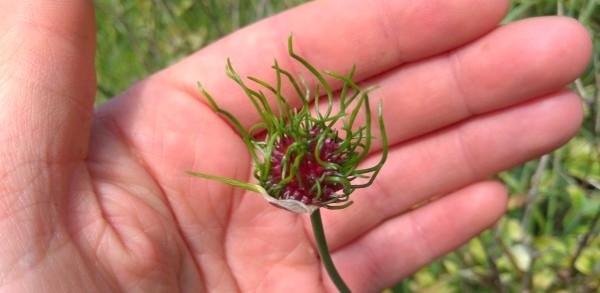
Wild onion
The Alliums are a well-known group of plants among gardeners and cooks, comprising the onions, chives and garlics so familiar to us. Sometimes on my farm surveys and walks I come across a lesser-known wild representative of this family– the wild onion, Allium vineale. This is one of those plants which has umpteen common names depending on what you’re taught or where you’re from: crow garlic, onion grass, stag's garlic, compact onion, false garlic, and even wild garlic. Legendary UK botanical taxonomist Professor Clive Stace calls it wild onion, therefore so will I!
The wild onion is quite difficult to spot for much of the year because its chive-like leaves are easily camouflaged amongst grass. The self-fertile flowering head is much more obvious, appearing in June or July as a marble-sized ball covered in a papery sheath which breaks open to reveal a dense cluster of pink ‘bubils’. These are the main reproductive feature of the wild onion and can often be seen sprouting new shoots which appear as curled green tendrils, make the flowerhead look rather like Medusa! Sometimes, the bubils produce stalked pink flowers as well. The underground ‘true’ onion bulb is 1-2cm in diameter and this, along with the leaves and bubils have a strong onion-garlic flavour.
It’s certainly not everyone’s favourite wildflower – this plant can be a serious pest in pastures and cereal crops particularly in the light sandy or chalky soils of south-east of England, but it peters out the further north you go and is rarely seen in Ireland and Scotland. When consumed by livestock, the leaves impart a garlic-like flavour and odour on dairy and beef products – and no-one would want garlicky milk on their cornflakes! Grain harvests can become tainted if the wild onion bubils go into the combine with the cereals. These examples show the potency of the sulfuric compounds that comprise the taste and smell of onion and garlic… I found this out once when I didn’t reseal my ice cream properly and put it in the freezer next to red onions!
The internet is full of advice on how to kill wild onion because it is an invasive weed in parts of North America, Australia and Kenya. It is pretty resistant to herbicides, which cannot cling well to the vertical, smooth and waxy structure of its leaves and when you pull it up its bulbs dissect, leaving smaller clusters behind to spread.
Though the wild onion is not revered nowadays, the bulb-forming onions and garlicsas a family are steeped in human history. The plain old brown onion Allium cepa is one of the oldest and most-used ingredients in the world; yet, its true wild ancestor is curiously unclear because many different species around the world in respective cultures are referred to as the ‘wild onion’ and the cultivation history is so ancient and widespread. However, our wild onion Allium vineale is native to Europe, northwest Africa and central Asia so it’s a possible candidate. Allium consumption has been traced back to Bronze Age China and Ancient Egypt. And they weren’t just eaten: traces of onion were found in the eye sockets of the mummy of Ramesses IV – a cruel send-off you might think, if you’ve ever sobbed over a chopping board – but actually onions were stuffed into the skulls to symbolise eternal life!
Apart from carrying your immortal soul, onions have other recognised health benefits. The leaves and roots of our wild onion can be prepped to act as an “antiasthmatic, blood purifier, carminative, cathartic, diuretic, expectorant, hypotensive, stimulant and vasodilator” according to one source, as well as preventing worms and colic in children and reducing blood pressure and cholesterol. Edible Alliums in general are a healthy addition to the diet.
So next time you tuck into a meal containing onions or garlic, think of that little pest out in the field with a crazy hair-do which, thousands of years ago, might have been an important historical turning point in agriculture, nutrition and medicine!
Jess Brooks
Advisory

Get Peter Thompson's essential 26-page book, featuring beautiful photography and detailed profiles of Britain's wildlife, for just £1.99.
Find out more >